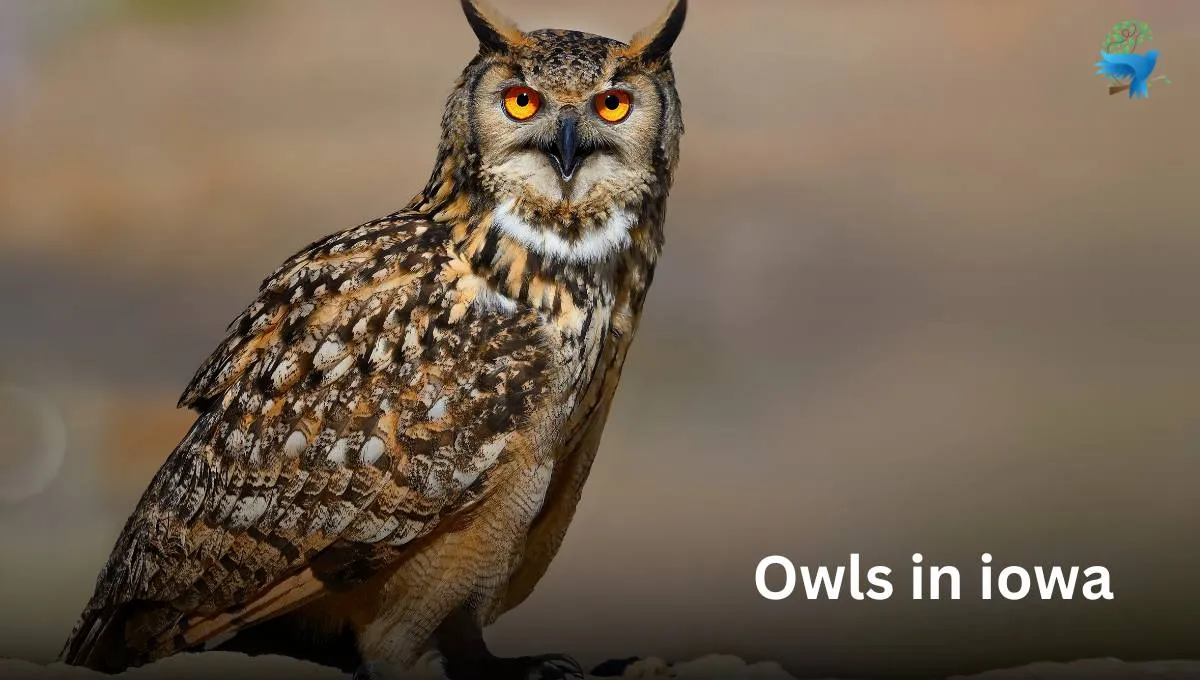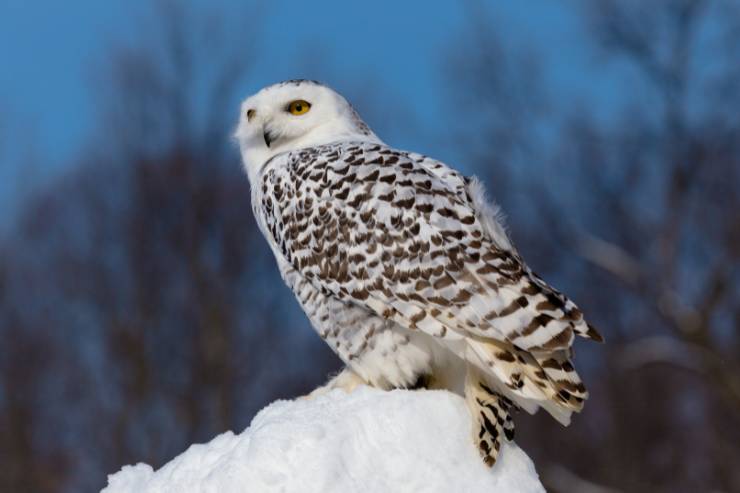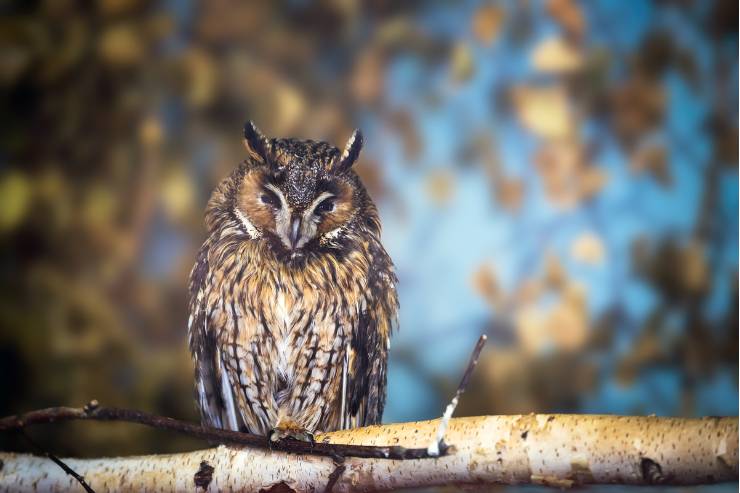5 Owls in iowa

Various owls grace the skies in Iowa, complementing the state’s ecosystems with their mysterious presence.
Iowa’s majestic birds are not only limited to populations but also act as attractive representatives for the state’s natural heritage.
Several owl species live in Iowa, including the great horned owl, barred owl, long-eared owl, and, on rare occasions, the snowy owl during the winter.
Each species has unique environmental preferences and behaviors. So, let’s move forward and learn about the magnificent birds in Iowa.
List of 5 Owls in Iowa
- Great Horned Owl
- Snowy Owls
- Barred Owl
- Barn Owl
- Long-Eared Owl
1. Great Horned Owl
- Scientific name: Bubo Virginianus
- Size: 46–63 centimeters (18.1–24.8 inches)
- Mass: 910–2500 grams (32.1–88.2 oz)
- Wingspan: 101–145 centimeters (39.8)
- Beak Size: 3.81 centimeters (1.5 inches)
- Life Span: 20–30 years
- Conservation Status: Least Concern
The great horned owl, often known as the hoot owl or the tiger owl, is a vast owl common to the Americas.
It is a highly adaptable bird with an extensive range and the most extensively dispersed true owl in the Americas.

Great Horned Owls have mottled gray-brown bodies, reddish-brown cheeks, and a tidy white patch on the throat. The general color tone varies by area, from sooty to pale.
Their eyes do not move in their sockets, but they can tilt their heads 360 degrees to view in any direction.
A long-lived great-horned owl can survive for 20-30 years in the wild; the oldest reported great-horned owl was a captive female who was 50 years old.
| Great horned owls can apply approximately 2000 kilopascals (300 pounds per square inch) of pressure when gripping their claws, which are used to cut off prey spines. |
Habitat: The great horned owl is one of North America’s native owls. It thrives in deserts, ponds, woods, grasslands, backyards, cities, and nearly any other semi-open habitat between the Arctic and the tropics.
Feeding: The great horned owl’s major food consists of rabbits, rats, and voles, although it freely hunts whatever animal it can catch, including rodents and other small mammals.
2. Snowy Owls
- Scientific name: Bubo Scandiacus
- Size: 52–71 centimetres (20.5–27.9 inches)
- Mass: 1600–2950 grams (56.4–104.1 oz)
- Wingspan: 126–145 centimeters (49.6–57.1 inches)
- Beak Size: 5.08 centimeters (2 inches)
- Life Span: 10 years (in the Wild) and 28 years (in captivity)
- Conservation Status: Endangered (Population is declining).
The Snowy Owl is an elegant and distinctive bird recognized for its stunning and magnificent look. It is also known as the Arctic white owl. Snowy owls are big, white birds from the true owl family.

They have various amounts of black or brown patterns on their bodies and wings. This can be pretty dense on females, giving the bird a salt-and-pepper appearance.
Males tend to be paler and whiter as they mature.
| The Snowy Owl population is shrinking and is now classified as “vulnerable” to worldwide extinction. |
Twenty years ago, it was thought there were 100,000 pairs, but that figure has lately been reduced to around 14,000 pairs worldwide because the same birds were recorded many times as they traversed.
Snowy owls can survive for a decade or more in the wild and 28 years in captivity.
Habitat: The Snowy Owl lives primarily in the Arctic, in broad, treeless tundra. It usually sits on the ground or small posts.
Feeding: Their preferred prey are lemmings and small mouselike rodents, but they sometimes hunt rabbits, birds, and fish.
3. Barred Owl
- Scientific name: Strix Varia
- Size: 43–50 centimeters (16.9–19.7inches)
- Mass: 470–105 grams (16.6–37.0 oz)
- Wingspan: 99–110 centimeters (39.0–43.3 inches)
- Life Span: 8 years.
- Conservation Status: Least Concern
The barred owl, also known as the northern barred owl, striped owl, hoot owl, or eight-hooter owl, is a big owl species native to North America.
Its feathers have been adorned with amazing horizontal barring that runs across its belly, wings, and back, resulting in a one-of-a-kind and captivating pattern.

Most other owls have yellow eyes, but the Barred Owl has brown eyes. It has a little pointed, dull yellow beak.
The average life span of a Barred Owl in the wild is about eight years. It has a Continental Concern Score of 7 out of 20, indicating minimal conservation concern.
Habitat: The barred owl inhabits woodlands, wooded river bottoms, and wooded marshes. This species prefers dense, thick woods with few clearings, particularly in low-lying and swampy locations.
Barred owls are most prevalent in deciduous or mixed woodlands in the southeast, but they can also be found in mature conifers in the north and northwest.
Feeding: Barred owls primarily prey on mammals (shrews, voles, and rats), but they will also eat other birds, crabs, fish, and earthworms.
4. Barn Owl
- Scientific name: Strix Varia
- Size: 40–63 centimeters (15–25 inches)
- Mass: 610–1150 grams (1.34–2.54 oz)
- Wingspan: 96–125 centimeters (38–49 inches)
- Life Span: 4 years
- Conservation Status: Low concern
The barn owl is the world’s most widely spread owl species. It is sometimes known as the common barn owl.
Barn Owls are often pale in color with black eyes. The head, back, and upper wings are a mix of buff and gray, while the face, body, and underwings are all white.

When observed at night, Barn Owls can look completely white.
Barn Owls have a lifespan of 4 years, with the oldest reported in the wild being 15 years. In captivity, they can live up to 20 years, although most die early.
| Fact: Approximately 70% of Barn Owls who grow up die within the first year. |
Habitat: The Barn Owl lives in various habitats and altitudes, including deserts, grasslands, woodlands, agricultural fields, and urban areas.
This species is found in most environments across the state. They can be found near agricultural regions or basalt cliffs, in woodland openings, wetlands, and other open spaces.
Feeding: Barn Owls mostly eat rodents and rely heavily on voles; they also consume other types of mice, tiny rats, shrews, juvenile rabbits, and other mammals.
These species eat few birds, lizards, insects, and, on rare occasions, frogs and fish.
5. Long-Eared Owl
- Scientific name: Asio Atus
- Size: 31–40 centimeters (12–16 inches)
- Mass: 160–435 grams (5.6–15.3 oz)
- Wingspan: 86–102 centimeters (– inches)
- Life Span: 12 years and 1 months old
- Conservation Status: Least Concern
The long-eared owl, also known as the northern long-eared owl or, more commonly, the lesser horned owl or cat owl.

It is a medium-sized owl with an extensive breeding range. Long-eared Owls are dark-colored birds with buff or orange faces and exquisite black, brown, and buff feather patterning.
The ear tufts are black with buff or orange fringes, and the face has two vertical white lines between its eyes.
One of its most noticeable features is its bright orange eyes, which add an elegant touch to its overall appearance.
The oldest Long-eared Owl on record was at least 12 years and one-month-old.
| The IUCN classifies it as the least concern species. Nonetheless, long-eared owl owls have experienced substantial declines in numerous regions of its range. |
Habitat: The Long-Eared Owl likes woodlands and conifer groves. These species prefer densely forested areas for nesting and roosting and open land for hunting.
They live in a wide range of habitats, including forests with vast meadows, conifers or deciduous trees in the prairie region, and streamside groves in the desert.
Feeding: The Long-Eared Owl feeds primarily on common local rodents. Depending on the region, the most common animals include voles, deer, mice, gophers, etc.
They are also known to devour tiny birds, shrews, bats, lizards, snakes, and other small critters.
Conclusion
Iowa owls, with their unique habits and ecological roles, are critical to the state’s environment.
From the adaptable Great Horned Owl to the vulnerable Snowy Owl, these creatures represent both resilience and fragility.
Barred, Barn, and Long-Eared Owls contribute to Iowa’s ecosystems by showing their diverse habitats. Their diverse habits and conservation issues highlight the natural world’s delicate equilibrium.
Protecting these beautiful birds and their habitats is critical to preserving the biodiversity and the wellness of Iowa’s natural surroundings for future generations.
Frequently Asked Question
Are owls active during the day in Iowa?
While some owl species, such as the snowy owl, may be observed during the day, most owls in Iowa are night owls, meaning they are most active at night. However, they may be active at dawn and dusk, especially during breeding seasons.
Do owls migrate through Iowa?
Some owl species, such as the snowy owl, are known to migrate through Iowa at various periods of the year, particularly during the winter months. However, resident species such as the great horned and barred owl usually stay in Iowa year-round, though their territories may vary significantly.
What does an owl eat?
Owls are carnivorous and eat various animals based on their species and location. Iowa owls’ prey include rodents such as mice and voles, small birds, insects, amphibians, and, on occasion, small mammals like rabbits.






